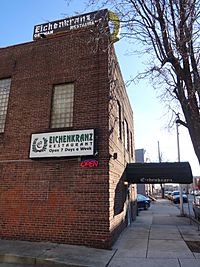History of the Germans in Baltimore facts for kids
The history of Germans in Baltimore began a long time ago, in the 1600s. In the 1800s, the Port of Baltimore was a very important place for people coming to America. It was the second busiest port for immigrants, right after Ellis Island in New York City. Many Germans moved to Baltimore during this exciting time.
Contents
German People in Baltimore
In 1880, most of the people born outside the United States in Baltimore were Germans. They made up 58% of all foreign-born residents. About 17% of Baltimore's total population was born in other countries. Out of these, 32,685 people were German, including those from different parts of Germany like Prussia and Bavaria.
By 1920, nearly 20,000 white people born outside the U.S. spoke German as their first language in Baltimore.
In 1940, about 9,744 immigrants from Germany lived in Baltimore. They made up 16% of the city's white population born in other countries. Overall, about 23,889 people in the city were either born in Germany or had German family roots.
By 2000, a large number of people in the Baltimore metropolitan area had German ancestors. About 18.7%, or 478,646 people, were of German descent. This made them the largest group of European ancestors in the area. In Baltimore city itself, 48,423 people were German, which was 7.4% of the city's population.
As of 2011, people from Germany were the seventeenth largest group of foreign-born residents in Baltimore. The German language was also the sixteenth most common language spoken by those who didn't speak English very well.
History of Germans in Baltimore
Early German Settlers (1700s)
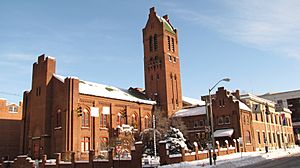
German immigrants started settling near the Chesapeake Bay around 1723. This was before Baltimore was even officially founded in 1729. In 1755, German Lutherans started the Zion Lutheran Church. This church also brought in settlers from Pennsylvania Dutch areas. To help new German immigrants, the German Society of Maryland was created in 1783.
German Immigration Booms (1800s)
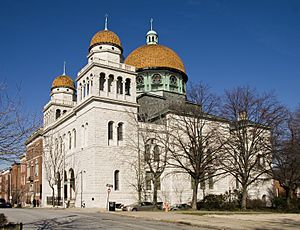
Coming to America
After the War of 1812 in North America, many Germans came to Baltimore. They came from places like the Palatinate, Hesse, and Bavaria. Many left Germany between 1812 and 1814 to avoid being forced into the army during the Napoleonic Wars.
Baltimore's port became a major entry point for immigrants in the 1820s. It soon became the second largest gateway to America, after New York City. This was especially true at the Baltimore and Ohio Railroad terminals in Locust Point, Baltimore. The railroad even made a deal with the Norddeutscher Lloyd, a German shipping company.
German Community Grows
By 1850, about 20,000 German-born people lived in Baltimore. Between 1820 and 1860, Germans were the largest group of immigrants coming to the city. These new arrivals created many German organizations. They started banks, insurance companies, and even newspapers. A strong German-language press grew, with papers like the Baltimore Wecker (Baltimore Alarm).
After the Revolutions
Immigration from Germany increased again after the Revolutions of 1848 across Europe. Thousands of people, sometimes called "Forty-Eighters", came to Baltimore. By the time of the American Civil War, there were 32,613 German-born residents in Baltimore. This number doesn't even include their American-born children or earlier settlers.
Many German immigrants were against slavery. German newspapers that spoke out against slavery were sometimes attacked by angry mobs. During the Baltimore riot of 1861, the office of the Baltimore Wecker was destroyed. Its publisher and editor had to leave the city because of the violence.
Continued Growth and New Institutions
The German population kept growing after the Civil War. This was partly due to a deal made in 1867 between the Baltimore and Ohio Railroad and the Norddeutscher Lloyd. This German steamship line brought tobacco and more German immigrants to Baltimore's port from Bremen, Germany. German immigrants would get off the ships at the B&O's pier in Locust Point.
By 1868, one-fourth of Baltimore's white residents were German-born. Half of the remaining white population had full or partial German heritage.
Many wealthy German Jews also arrived in the late 1800s. They created many cultural places, including Yiddish theatres. Starting in the 1870s, many rich German Jews built beautiful homes along Eutaw Place near Druid Hill Park. They also built several synagogues, like the Eutaw Place Temple. By 1880, about 10,000 German Jews lived in Baltimore. Most of them came from Bavaria and Hesse.
The number of German-born immigrants in Baltimore reached its highest point in 1890. At that time, 41,930 people out of Baltimore's total population of 365,863 were born in Germany.
German Churches
Holy Cross Church was founded in 1860. It was located in old South Baltimore near Federal Hill. This church served the growing number of Germans moving into that area. Later, St. Elizabeth of Hungary Roman Catholic Church was founded in 1895 in Highlandtown. This church served the German immigrant community in east Baltimore.
German Life in the 1900s
In 1900, the U.S. Census showed that Baltimore had 34,000 German residents. Around that time, over 30 churches in Baltimore held Sunday services in German. By 1914, the number of Germans had grown to 94,000, which was 20% of the city's population.
During the 1800s, many of the city's public schools were known as "German-English" schools. By the 1920s, one-third of Baltimore's public schools still taught German. A quarter of Baltimore residents could still speak German fluently. Before World War I, even the notes from the Baltimore City Council were published in both German and English.
World War II and Beyond
Before and during World War II, many Jewish refugees escaped from Germany and came to Baltimore. By the end of the war, about 3,000 of them had settled in the city.
Holy Cross Roman Catholic Church in the Federal Hill neighborhood was listed as a German church until 1959. This church had been very important to the large German community in South Baltimore.
The last German-language newspaper in Baltimore, the Baltimore Correspondent, stopped being published in 1976.
German Heritage Today (2000s)
Some parts of Baltimore's German heritage are still strong today. The Zion Lutheran Church has held services in both English and German for over 250 years. There is also an annual Maryland German Festival held in the Baltimore area. This festival is sponsored by the German-American Citizens Association of Maryland.
German-American Culture
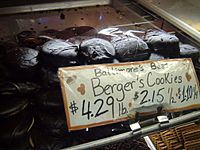
German-American Food
German immigrants brought new food ideas to Baltimore. They introduced popular items like Berger Cookies. The Schmidt Baking Company was started by Elizabeth and Peter Schmidt, German immigrants who used German recipes for their baked goods.
Baltimore used to have many German restaurants. However, by 2014, Eichenkranz was the only one left that served traditional German cuisine. Sadly, that restaurant also closed in 2015.
Famous German-Americans from Baltimore

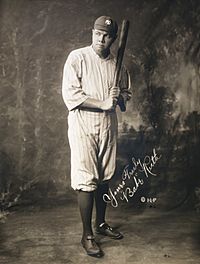
- Otto Eugene Adams, an architect.
- Lisa Aukland, a professional bodybuilder.
- Louis Bamberger, a leading citizen and philanthropist in Newark, New Jersey.
- Clara Beranger, a screenwriter during the silent film era.
- Philip Berrigan, a peace activist.
- Wendel Bollman, an engineer known for his iron railway bridges.
- David Bachrach, a commercial photographer.
- Elsbeth Levy Bothe, an attorney and judge.
- Gustav Brunn, who invented Old Bay Seasoning.
- Jacob I. Cohen Jr., a banker who helped Jews gain the right to hold public office in Maryland.
- Moses H. Cone, a textile business owner and philanthropist.
- Cone sisters, wealthy collectors of modern French art.
- David Einhorn, a rabbi and leader of the Jewish reform movement.
- Walter M. Elsasser, a physicist known for his theory about Earth's magnetism.
- Solomon Etting, a German-Jewish merchant and politician.
- Joseph Fels, a soap maker and philanthropist.
- George A. Frederick, an architect who designed the Baltimore City Hall.
- George Fruits, believed to be the last surviving soldier of the American Revolutionary War.
- Louise Glaum, an actress known for her roles as a "femme fatale" in silent movies.
- Brian Gottfried, a retired tennis player.
- William Hickley Gross, a leader in the Roman Catholic Church.
- Henry Gunther, the last soldier killed in World War I.
- Hilary Hahn, a violinist.
- David Hasselhoff, an actor, singer, and producer.
- August Hoen, who founded a prominent printing company.
- John Christian Keener, a Confederate Chaplain and Methodist bishop.
- Nick Kisner, a professional boxer.
- Isaac Leucht, a Reform Rabbi and community leader.
- Margo Lion, a producer for plays and musicals.
- August Mencken, Sr., father of H. L. Mencken and founder of a cigar factory.
- H. L. Mencken (Henry Louis Mencken), a famous journalist and writer from Baltimore.
- Ottmar Mergenthaler, an inventor who created the Linotype machine.
- Abbie Mitchell, a soprano opera singer.
- Herman N. Neuberger, an Orthodox rabbi and leader.
- John Neumann, a German Bohemian immigrant who became a Catholic priest.
- Hermann Oelrichs, a businessman and agent for Norddeutsche Lloyd shipping.
- Gustav Oelwein, who founded the city of Oelwein, Iowa.
- Wilhelm Rapp, an abolitionist and editor of the Baltimore Wecker newspaper.
- Isidor Rayner, a U.S. Senator from Maryland.
- Abraham Rice, the first ordained rabbi to serve in a rabbinical position in the United States.
- Dutch Ruppersberger, a U.S. representative for Maryland.
- George Herman ("Babe") Ruth, a legendary baseball player.
- Julius Sachs, an educator who founded Sachs Collegiate Institute.
- William Donald Schaefer, a politician who served in Maryland for 50 years.
- Carl Heinrich Schnauffer, a poet, soldier, and editor.
- Kurt Hugo Schneider, a video editor, musician, and singer known for YouTube music videos.
- Hans Schuler, a German-born American sculptor.
- Dwight Schultz, an actor and voice artist.
- Barry Sless, a musician skilled in guitar and pedal steel guitar.
- Rose Sommerfield, a teacher, activist, and social worker.
- Gertrude Stein, a writer of novels, poetry, and plays.
- Charles Stieff, an industrialist and piano maker.
- Louis J. Weichmann, a key witness in the trial of those involved in Abraham Lincoln's assassination.



